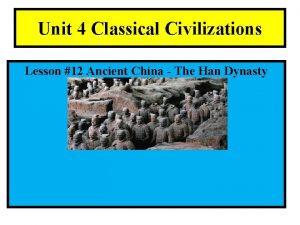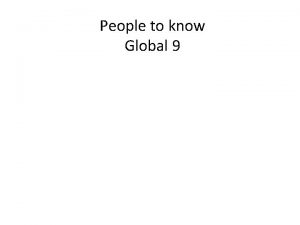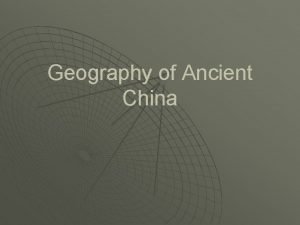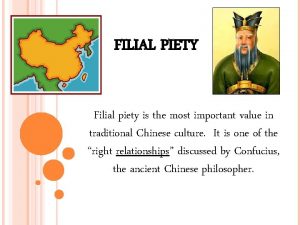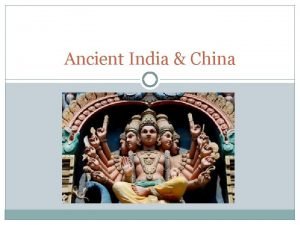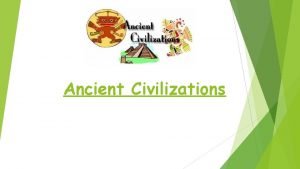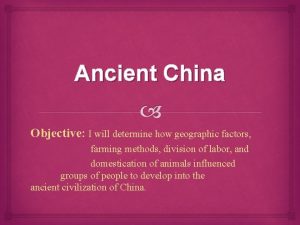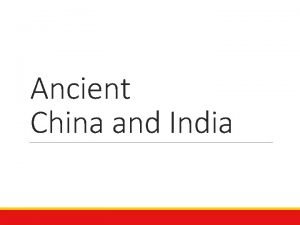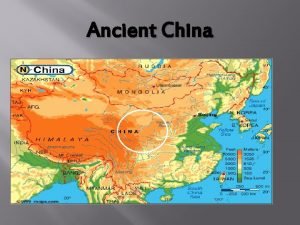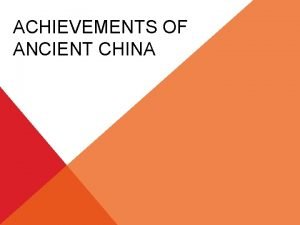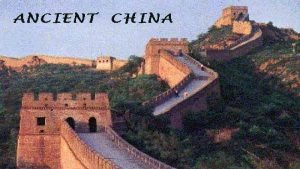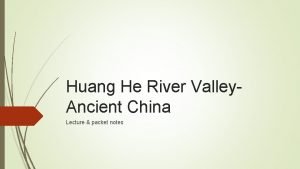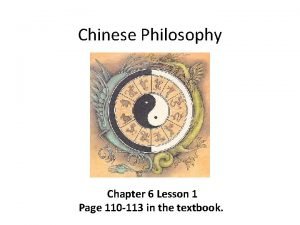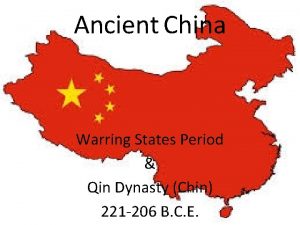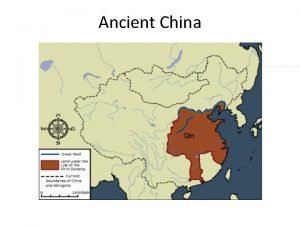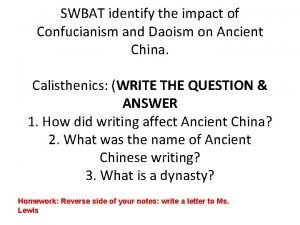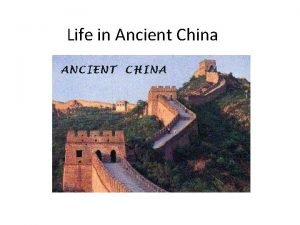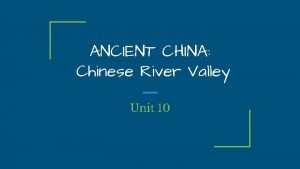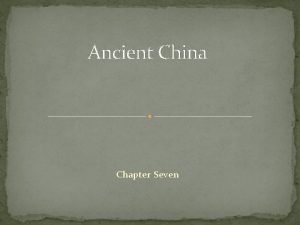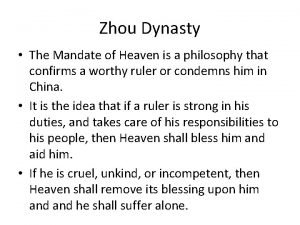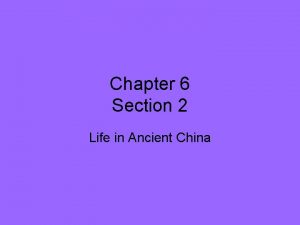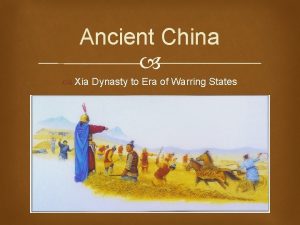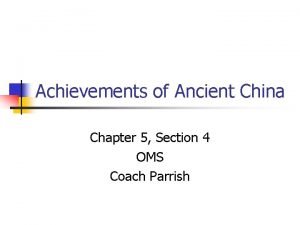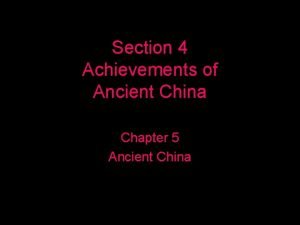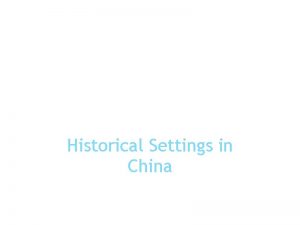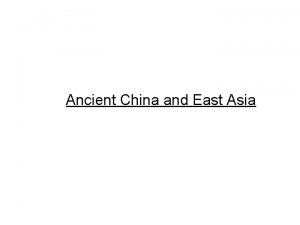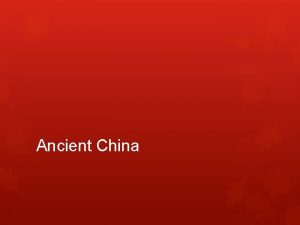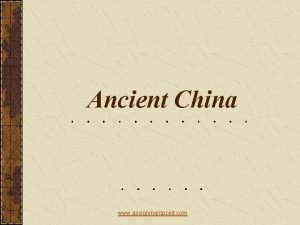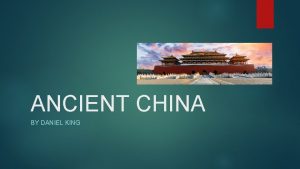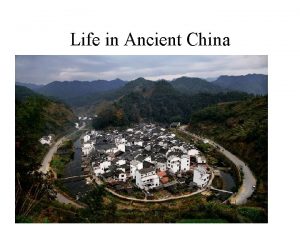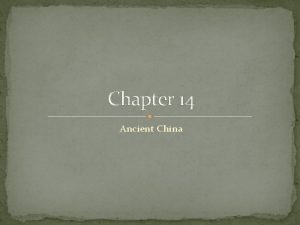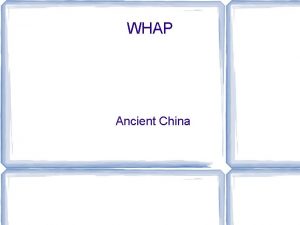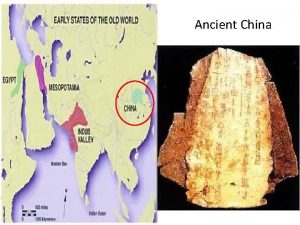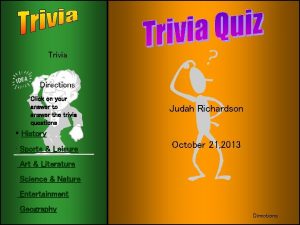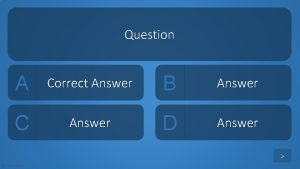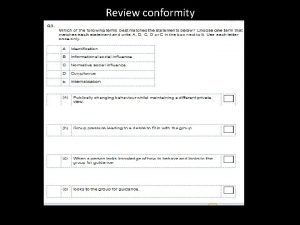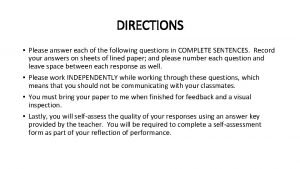Overview of Ancient China Directions Answer each of




























- Slides: 28

Overview of Ancient China

Directions: Answer each of the following either True or False: 1. The Silk Road was an ancient trade road between China and Japan. ______ 2. The Great Wall of China was begun before the birth of Christ. ______ 3. The Chinese are monotheistic. ______ 4. The peasants are at the bottom of the Chinese class structure. ______ 5. The Silk Road was a trade route between China and Europe. ______

China’s Geography [China is a large country with a varied landscape.

[The heart of China is dominated by its two major rivers, the Huang He and Chang (Yangtze).

[The Huang He is also called the Yellow River because is carries yellow soil called loess. It flows 2, 900 miles across China before it empties into the Yellow Sea.

[The Huang He is also called “China’s Sorrow” because of the flooding it can bring.

[The Chang or Yangtze River is Asia’s longest at 3, 434 miles long. It is an important trade route.

[China’s most fertile land in in the east – the North China Plain and the Manchurian Plain. M an c Pl hu ai ri n an North China Plain

[Much of the rest of China is dry – the Plateau of Tibet, the Gobi Desert, and the Taklimakan Desert.

M tn s Sh an Him alay as Pac ific Oce an Ti en Gobi Desert [ Because of China’s huge size, rugged mountains, and harsh deserts, it was difficult to invade.

[ Invaders usually came from the north – from areas such as Mongolia and Manchuria. [ Later the Chinese will build the Great Wall to keep out the invaders.

Under the Qin Dynasty, Chinese civilization was unified, and the Great Wall was built. https: //app. discoveryeducation. co m/player/view/asset. Guid/c 3 db 6 c 2 c-cbde-409 d-b 0 f 6 -70 e 0 cd 6 a 54 b 8 When was the Qin Dynasty? Why/When was the Great Wall built? 3 rd Fact: Students Choice



Great Wall statistics… [4, 160 miles long! [It’s only 3, 610 miles from New York City to Paris, France. [It’s only 3, 095 miles from San Francisco, California to Boston, Mass.

Early Chinese Civilizations [ The Chinese considered themselves the center of the earth and of civilization so they called their country the Middle Kingdom. Outsiders were considered barbarians.

[ Earliest Chinese Civilization took place along the Huang He River. [ It later spread to the Yangzi River.

[ Trade with the Middle East took place along the Silk Road.


Social Structure [ Chinese often lived in clans which were groups of families who claimed a common ancestor. BASIC CLASS STRUCTURE rulers nobles merchants/artisans peasants (the majority of the population)

Social Structure [ Pyramids [ Look at your Indian Caste pyramids. How does the Chinese Class structure compare with the Ancient Indian caste structure? BASIC CLASS STRUCTURE rulers nobles merchants/artisans peasants (the majority of the population)

Religion [ Chinese were polytheistic (believed in many gods and nature spirits) [ They prayed to their ancestors because they were links to the gods

Ancestor worship in China

Religion [ Believed in two forces of nature called Yin(female) and Yang (male) that needed to be in harmony. People often did things to destroy this harmony.

Religion [ Used Oracle Bones to tell the future (interpreted by priests).

Language [Mandarin is a difficult language to learn because there are over 10, 000 characters. [Used pictograms and ideographs. [Chinese known for calligraphy- elegant handwriting. [Chinese couldn’t understand each other’s spoken language but all used the same written language.

Government [ China was ruled by a series of dynasties – a line of rulers from the same family. [ The large government was organized into a bureaucracy – a government with many levels. [ Chinese believed in the concept called the Mandate of Heaven which says that a ruler will stay in power as long as he rules well and strongly but will lose power if he becomes weak and corrupt. Then another dynasty will start. [ The rise and fall of dynasties is called the Dynastic Cycle.

Directions: Answer each of the following either True or False: 1. The Silk Road was an ancient trade road between China and Japan. ______ 2. The Great Wall of China was begun before the birth of Christ. ______ 3. The Chinese are monotheistic. ______ 4. The peasants are at the bottom of the Chinese class structure. ______ 5. The Silk Road was a trade route between China and Europe. ______
 Ancient india vs ancient china
Ancient india vs ancient china Engineering an empire china worksheet
Engineering an empire china worksheet Ancient china han
Ancient china han Social classes in the han dynasty
Social classes in the han dynasty Mansa musa accomplishments
Mansa musa accomplishments Ancient china on a map
Ancient china on a map Why is filial piety important
Why is filial piety important Ancient china confucius
Ancient china confucius Ancient china confucius
Ancient china confucius Huang he
Huang he Ancient china social class
Ancient china social class Physical map of ancient china
Physical map of ancient china Shang dynasty achievements
Shang dynasty achievements Helped overthrow the qin dynasty
Helped overthrow the qin dynasty Huang he river civilization
Huang he river civilization Han feizi quote
Han feizi quote Ancient china people
Ancient china people Ancient china zhou dynasty
Ancient china zhou dynasty What was the impact of daoism in ancient china
What was the impact of daoism in ancient china Primitive period of physical education
Primitive period of physical education Terrace farming in ancient china
Terrace farming in ancient china What is believed to be the 1 stdynasty of ancient china?
What is believed to be the 1 stdynasty of ancient china? Himalayan mountains ancient china
Himalayan mountains ancient china Zhou dynasty mandate of heaven
Zhou dynasty mandate of heaven How long ago was ancient china
How long ago was ancient china Why did many aristocrats favor the philosophy of legalism?
Why did many aristocrats favor the philosophy of legalism? Ancient china craftsmen
Ancient china craftsmen Achievements of china
Achievements of china Han dynasty achievements
Han dynasty achievements



